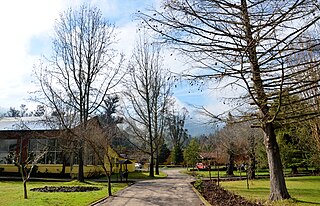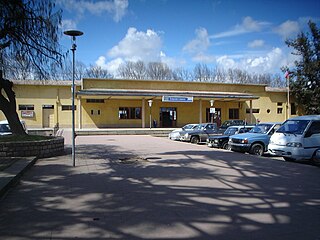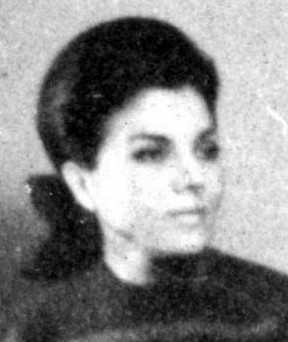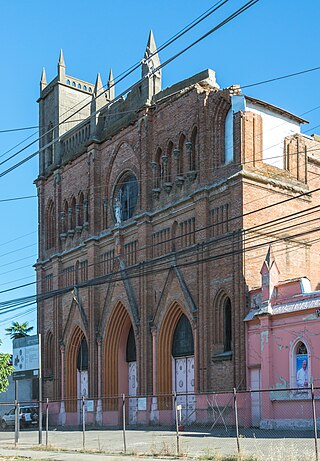Ancoa is a river, tributary of the Achibueno, in Linares Province, Maule Region of Chile.
Ancoa is a river, tributary of the Achibueno, in Linares Province, Maule Region of Chile.
35°55′07″S71°23′51″W / 35.91853°S 71.39757°W

Linares is a Chilean city and commune located in the Maule Region and lies in the fertile Chilean Central Valley, 303 km (188 mi) south of Santiago and 50 km (31 mi) south of Talca, the regional capital. Linares is the capital city of the province of Linares.

The Diocese of Linares is a Latin Church ecclesiastical territory or diocese of the Catholic Church in Linares, Chile. It was established by Pope Pius XI on October 18, 1925 in his papal bull Notabiliter Aucto.

Quinamávida is a Chilean village in the commune of Colbún, Linares Province, Maule Region. Quinamávida is well known in Chile as a popular hot springs and resort spa.

The Longaví River is a tributary of the Maule River, in the Province of Linares, Maule Region of Chile. The Longaví is 120 km long.
Huerta del Maule or Huerta de Maule is a Chilean hamlet (caserío) in San Javier, Linares Province, Maule Region. This picturesque and bucolic place, with a current permanent population of less than 300, used to have far more importance and population two centuries ago, having been a strategic place because of its location at the south of the Maule river and west of the Loncomilla River in central Chile, over the busy, old colonial route from Santiago - Talca to Concepción.

Achibueno is a river, tributary of the Loncomilla, in Linares Province, Maule Region of Chile, where it forms the border between the municipalities of Linares and Longaví.

Putagán is a river in Linares Province, Maule Region of Chile. The Putagán is born in the foothills of the Andes and, flowing from east to west, passes south of the village of the same name. Along its course, the river contributes to form the northern border of the municipality of Linares with the following municipalities : Colbún, Yerbas Buenas and Villa Alegre, before joining the Loncomilla river.
Putagán is a village in the Chilean municipality of Villa Alegre, Province of Linares, Maule Region. Pop. 622. Altitude (meters) 112. Time zone (est) UTC−4(-3DT). Located 292 Kilometers south of Santiago. Its economy is based around agricultural activities like vineyards, rice, corn plantations, and lately berries for the European markets.

The Maule river or Río Maule is one of the most important rivers of Chile. It is inextricably linked to the country's pre-Hispanic (Inca) times, the country's conquest, colonial period, wars of Independence, modern history, agriculture, culture, religion, economy and politics. The Maule River marked the southern limits of the Inca Empire. Many famous men and women in Chile's history have been born in the Region named after the river. The river has also lent its name to one of the viticultural regions of the country, the Valley of Maule, a subregion of the Central Valley.

Loncomilla River is a tributary to the Maule river in Linares Province, Maule Region, Chile. Two rivers join to form the Loncomilla River: the Perquilauquén river and Longaví river.

The Purapel river is a tributary of the river Perquilauquén, and traverses parts of the Talca and Linares provinces, in the Maule Region of Chile. It is born in the Cordillera de la Costa, near Empedrado, forms part of the border between these two provinces and, in its lower course, forms part of the border between the provinces of Linares and Cauquenes.

The Melado is a river of Linares province, Maule Region, of Chile. It rises in the "Cordillera de los Andes" with the name of river Guaiquivilo where it is formed by two tributaries, the river Cajón Troncoso, originating near the Argentine border and the river Palaleo, from the outflow of Dial lake, located some 70 km upstream from the joining of the two rivers. The Guaiquivilo flows northwardly along a typical interandean longitudinal valley.

The Lircay River is a tributary of the Claro River, near the city of Talca in Chile. It is not to be confused with the Lircay River of Linares.
Abránquil is a Chilean village located in current Linares Province, near Yerbas Buenas. It is located in the riverside of the creek also named Abránquil.

Estación Talca is a railway station of the Empresa de los Ferrocarriles del Estado, located in Talca, Chile. It is the main railway station in the Maule Region. It is located on 11 Oriente avenue. Estación Talca is part of the Red Sur EFE, the TerraSur and the Expreso Maule inter-city services have a stop here. The nearby Talca Bus Terminal is within walking distance from the Station.

Estación Linares is a railway station of the Empresa de los Ferrocarriles del Estado, located in Linares, Chile. It is the main railway station in the Linares Province, and is located on Brasil Avenue.

The St. Ambrose Cathedral Also Linares Cathedral Is a cathedral church of Catholic worship, home of the Diocese of Linares in the Maule Region in Chile. It was built between 1935 and 1937.

Silvia Araya was a Chilean-born Canadian painter and art instructor. After founding the Chilean-Indian Institute of Culture, she joined the "Grupo Ancoa" and was a co-founder of the Museum of Art and Artisans of Linares, where she has sculptures and paintings in the permanent collection. In the 1970s, she became involved in politics and was elected to the Chamber of Deputies in 1973, representing the then Province of Coquimbo. After the coup d'état, she was imprisoned in the infamous Valparaíso prison, before being exiled to Canada in 1977. Locating in Quebec City, Araya established the Académie des beaux-arts Silvia Araya and taught for twenty-five years. She was honored as a knight of the National Order of Quebec in 2008 for her cultural contributions to the province.

The Iglesia del Corazón de María is a Catholic church located in the city of Linares, Maule Region, Chile. Inaugurated in 1905, it was declared a National Monument of Chile in 1995, within the category of Historic Monuments.
Linares Urban Wetland, also known as Ayüwün, is an urban wetland located in the city of Linares, Chile. Using the Urban Wetlands Law the Ministry of the Environment has declared 1.1 hectares of it a protected area. The borders of the protected area were as of April 2023 in a process of revision for an eventual expansion.